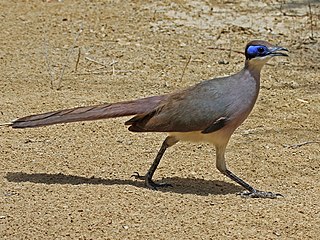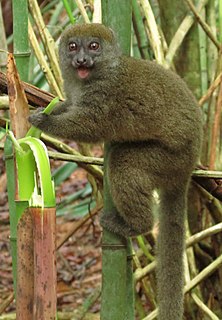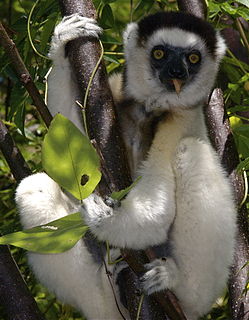
The Madagascar lowland forests or Madagascar humid forests are a tropical moist broadleaf forest ecoregion found on the eastern coast of the island of Madagascar, home to a plant and animal mix that is 80 to 90% endemic, with the forests of the eastern plain being a particularly important location of this endemism. They are included in the Global 200 list of outstanding ecoregions.

The Madagascar dry deciduous forests represent a tropical dry forest ecoregion situated in the western and northern part of Madagascar. The area has high numbers of endemic plant and animal species but has suffered large-scale clearance for agriculture. They are among the world's richest and most distinctive dry forests and included in the Global 200 ecoregions by the World Wide Fund. The area is also home to distinctive limestone karst formations known as tsingy, including the World Heritage Site of Bemaraha.

Ankarafantsika National Park is a national park in the Boeny Region of Madagascar. The closest city is Majunga 115 kilometres (71 mi) north of the park. Ankarafantsika is mostly tropical in climate type. The Sakalava people are the predominant ethnic group living and farming here. The greater big-footed mouse lives in the park and is not known anywhere else.

The Masoala fork-marked lemur, also known as the eastern fork-marked lemur or Masoala fork-crowned lemur, is a species of lemur found in the coastal forests of northeastern Madagascar. It is a small nocturnal animal with large eyes, greyish fur and a long tail.

The blue coua is a species of bird in the cuckoo (Cuculidae) family. It is endemic to the island of Madagascar.

The red-capped coua is a species of cuckoo in the family Cuculidae. It is endemic to Madagascar.

The western lesser bamboo lemur, also known as the northern bamboo lemur, western gentle lemur, or Sambirano lesser bamboo lemur, is species of bamboo lemur endemic to Madagascar.

The Kirindy Mitea National Park is a national park on the coast of the Mozambique Channel, in south-west Madagascar. The 72,200 hectares park contains many endemic animals and plants and claims to have the greatest density of primates in the world.

Tsimanampetsotsa National Park also spelt Tsimanampetsotse, and known as Tsimanampetsotsa Nature Reserve is a 432 km2 national park on the south-west coast of Madagascar in the region Atsimo-Andrefana. The park is 90 kilometres (56 mi) south of Toliara and 950 kilometres (590 mi) south of the capital, Antananarivo. Route Nationales (RN) 10 to Faux Cap passes the park and the nearest airport is at Toliara.

Andranomena Special Reserve is a wildlife reserve in Menabe Region, western Madagascar, near the city of Morondava and the rural commune of Bemanonga.

Ambatovaky Reserve is a tropical rainforest and wildlife reserve in the north-east of Madagascar. It is designated by Bird Life International as an Important Bird Area for the large number of endemic species of birds.

Ambohijanahary Special Reserve is a wildlife reserve in the regions of Menabe and Melaky in Madagascar. The reserve was created in 1958 to protect the sclerophyllous forest between Tsiroanomandidy and Maintirano, as well as protecting the many endemic species of plants and animals.

Ambohitantely Reserve or Ambohitantely Special Reserve is a 5,600-hectare (14,000-acre) wildlife reserve of Madagascar.

Anjanaharibe-Sud Reserve is a wildlife reserve in the north-east of Madagascar. The reserve was designated in 1958 and contains some of the last intact primary rainforest, along with several, rare and endemic animals and plants. The area was nominated to the UNESCO Tentative List of World Heritage Sites in Madagascar in 2008, as an extension of the rainforests of the Atsinanana.

Bemarivo Reserve is a wildlife reserve in the north-west of Madagascar. It was created in 1956 and covers an area of 12,080 hectares. The reserve is known for its fauna especially endemic birds.

Bora Special Reserve is a wildlife reserve in the Sofia Region of Madagascar, between the villages of Antsohihy and Bealalana. Bora is in a transition zone between eastern humid forests and western dry forests and the reserve and has many endemic species including six lemur species, twenty birds and over 150 species of endemic plants.

Kalambatritra Special Reserve is a wildlife reserve in southern Madagascar. It is to the north of Andohahela National Park, south-west of the Manombo Special Reserve and contains many endemic species, including forty-five endemic bird species.

Kasijy Special Reserve is a 19,800 hectares wildlife reserve in the Betsiboka region of Madagascar. Nearly half of the species of plants and animals recorded within the reserve are endemic to Madagascar and BirdLife International have listed the reserve as an Important Bird Area.

Mangerivola Special Reserve is a wildlife reserve in the east of Madagascar. It was established in 1958 and is a hotspot for bird-watchers due to the one hundred species found there, including 63 endemics and many local endemics. There are also seven species of lemur and rare chameleons such as the Lance-nosed chameleon which is registered as endangered on the IUCN Red List of Threatened Species.

Tsitongambarika is a lowland forest in southern Madagascar. The area supports many rare species of amphibians, birds, lemurs and reptiles; many of which are endemic. In 2001 the site was designated as an Important Bird Area by BirdLife International and in 2015, an area of 600 km² received environmental protection by the government. The reserve is the recipient of monies raised by the 2016 Rutland Birdfair.
























